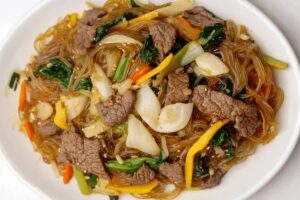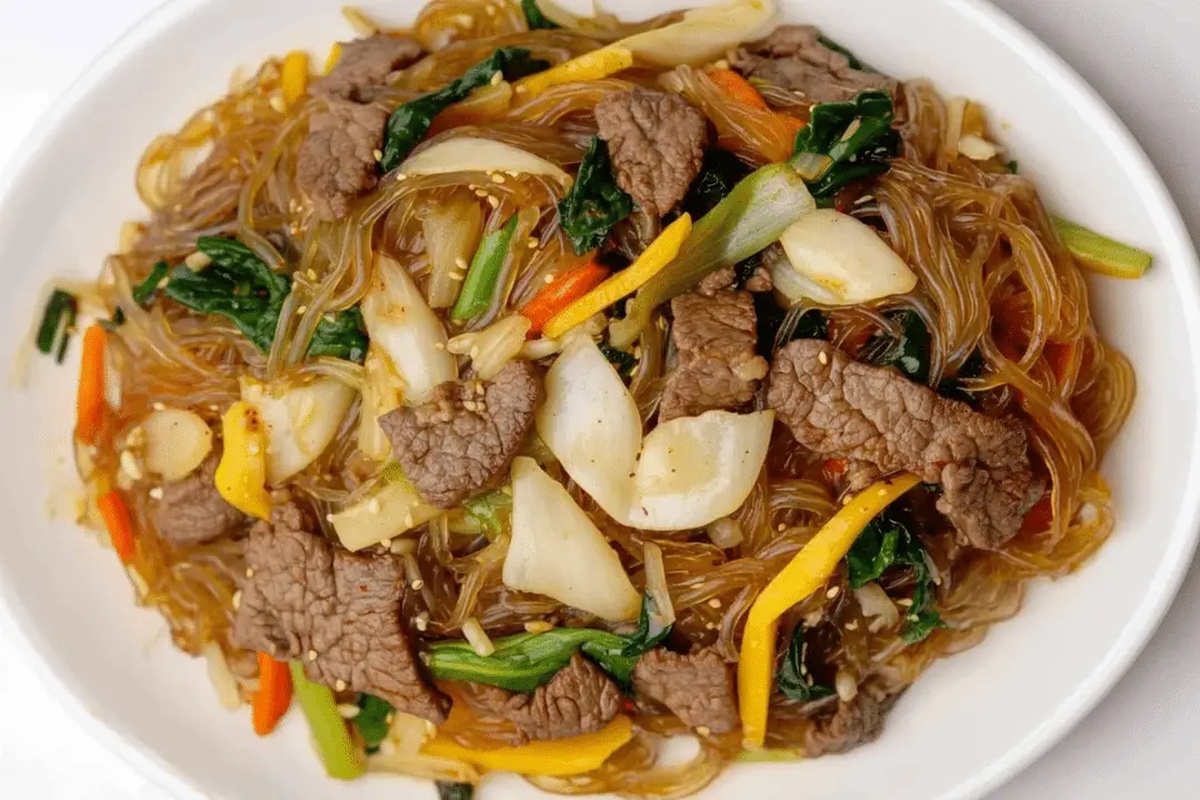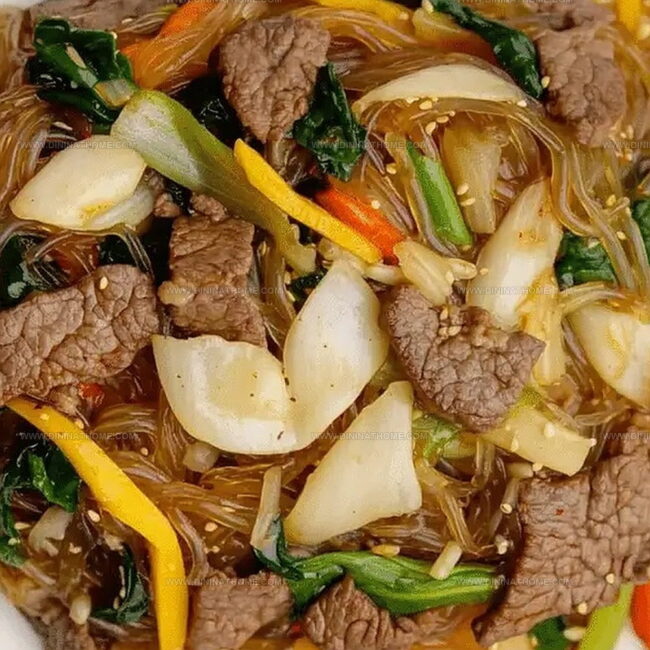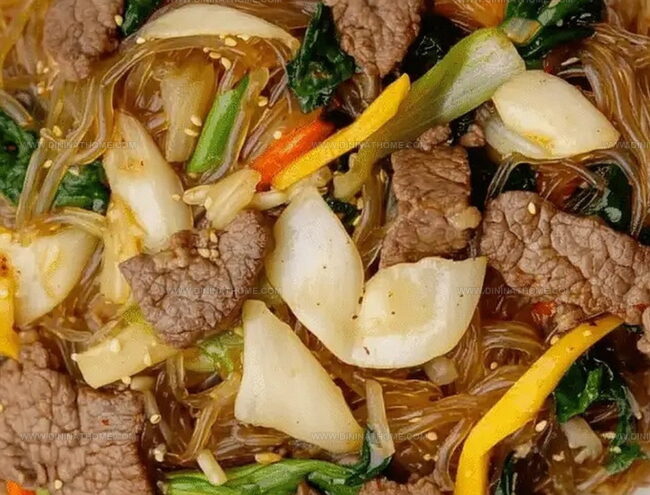Sizzling Beef Japchae: A Simple Korean Glass Noodles Recipe
Discover a mouthwatering beef japchae that weaves together vibrant Korean glass noodles with rich, savory flavors.
Silky sweet potato strands dance through colorful vegetables and tender meat slices.
Korea’s beloved classic brings excitement to your dinner table with minimal effort.
Each twirled bite promises an adventure of textures and tastes.
Seasonal veggies add bright crunch to the glossy noodle medley.
Cooking becomes simple magic when traditional techniques meet fresh ingredients.
Let this remarkable dish transport you straight to seoul’s bustling street kitchens.
Beef Japchae With Sweet Soy, Noodles, and Savory Cravings
Beef Japchae (Glass Noodles) Ingredients
Main Protein:Noodles:Vegetables:Seasoning Group:Aromatics:Garnish:Japchae Stir-Fry Noodle Prep
Step 1: Marinate Flavorful Beef
Slice beef and blend with tasty seasonings in a mixing bowl.
Coat the meat thoroughly with rich marinade ingredients:Let the beef soak up delicious flavors for at least 15 minutes.
Step 2: Prepare Silky Noodles
Boil sweet potato glass noodles following package directions.
Drain noodles and rinse under cool water.
Gently toss noodles with sesame oil to prevent clumping.
Step 3: Sauté Colorful Vegetables
Warm a skillet with sesame oil over medium heat.
Toss and cook vibrant vegetables:Stir-fry for 2-3 minutes until vegetables soften slightly.
Add fresh spinach and cook until delicately wilted.
Transfer vegetables to a separate plate.
Step 4: Cook Tender Beef
Use the same skillet to cook marinated beef over medium-high heat.
Sear beef until edges turn golden brown and meat cooks through, about 3-4 minutes.
Step 5: Combine Delectable Ingredients
Mix cooked noodles, beef, and vegetables in a large serving bowl.
Whisk sauce ingredients together and drizzle over the mixture.
Toss everything until well combined.
Step 6: Finish With Garnish
Sprinkle toasted sesame seeds and chopped green onions on top.
Serve immediately while warm or enjoy at room temperature.
Stir-Fry Ideas for Korean Beef Japchae
Beef Japchae Storage Tips
What Complements Korean Beef Japchae
Beef Japchae Korean Noodle Twists
FAQs
Sweet potato noodles are made from sweet potato starch, creating a transparent, chewy texture that’s gluten-free and unique to Korean cuisine.
Yes, you can substitute beef with chicken, pork, or tofu for a different protein option while maintaining the classic japchae flavor profile.
After boiling, rinse noodles with cold water and toss with a tablespoon of sesame oil to keep them separate and prevent clumping.
Japchae is versatile and can be served as both a side dish and a main course, depending on the occasion and personal preference.
Print
Beef Japchae (Korean Glass Noodles) Recipe
- Total Time: 35 minutes
- Yield: 4 1x
Description
Korean comfort meets culinary artistry in this Beef Japchae, a symphony of glass noodles dancing with savory marinated beef and colorful vegetables. Rich, silky strands intertwine with umami-packed ingredients, inviting you to savor Seoul’s beloved noodle tradition.
Ingredients
Meat:
- 1/2 lb (225g) ribeye or sirloin, thinly sliced
Noodles and Vegetables:
- 8 oz (225g) sweet potato glass noodles (dangmyeon)
- 1 medium carrot, julienned
- 1 red bell pepper, thinly sliced
- 4 oz (115g) shiitake or cremini mushrooms, sliced (optional)
- 2 cups fresh spinach
- 2 green onions, sliced
Seasonings and Garnish:
- 4 tablespoons soy sauce
- 2 1/2 tablespoons brown sugar
- 3 tablespoons sesame oil
- 2 teaspoons minced garlic
- 1 teaspoon black pepper
- 1 tablespoon toasted sesame seeds (for garnish)
Instructions
- Prepare a flavorful marinade for the beef by combining soy sauce, sesame oil, brown sugar, minced garlic, and freshly ground black pepper in a mixing bowl. Submerge the sliced beef in the mixture and allow it to absorb the flavors for a minimum of 15 minutes.
- Fill a large pot with water and bring to a rolling boil. Carefully add sweet potato noodles and cook according to the package guidelines. Once tender, drain the noodles and immediately rinse under cold water to halt the cooking process. Gently toss the noodles with sesame oil to prevent clumping.
- Warm a skillet over medium heat and drizzle with sesame oil. Introduce carrots, bell peppers, and mushrooms to the pan, sautéing for 2-3 minutes until they become slightly crisp-tender. Incorporate spinach and continue cooking for an additional minute until the leaves wilt and become vibrant green. Transfer the vegetables to a separate plate.
- Using the same skillet, increase the heat to medium-high. Add the marinated beef and cook until it develops a rich, golden-brown exterior, approximately 3-4 minutes. Remove the beef from the heat once cooked through.
- In a spacious mixing bowl, gently combine the cooked noodles, sautéed beef, and prepared vegetables. Create a harmonious sauce by whisking together soy sauce, brown sugar, sesame oil, and minced garlic in a small bowl. Drizzle the sauce over the noodle mixture and thoroughly toss to ensure even distribution of flavors.
- Elevate the dish’s presentation by sprinkling toasted sesame seeds and thinly sliced green onions over the top. Serve the japchae either warm or at ambient temperature for an authentic Korean dining experience.
Notes
- Marinate beef for maximum flavor by letting it sit longer, up to 2 hours in the refrigerator for deeper taste penetration.
- Rinse sweet potato noodles thoroughly to remove excess starch, ensuring a perfect, non-sticky texture that allows each strand to shine.
- Customize vegetable selection based on seasonal availability or personal preference, keeping the core cooking technique consistent for authentic Korean taste.
- Make this dish gluten-free by using tamari instead of traditional soy sauce, maintaining the rich umami flavor without compromising dietary needs.
- Prep Time: 20 minutes
- Cook Time: 15 minutes
- Category: Lunch, Dinner
- Method: Sautéing
- Cuisine: Korean
Nutrition
- Serving Size: 4
- Calories: 380
- Sugar: 6 g
- Sodium: 900 mg
- Fat: 14 g
- Saturated Fat: 3 g
- Unsaturated Fat: 8 g
- Trans Fat: 0 g
- Carbohydrates: 51 g
- Fiber: 4 g
- Protein: 20 g
- Cholesterol: 50 mg




Emily Harper
Nutrition Consultant & Recipe Analyst
Expertise
Healthy Recipe Modification, Nutritional Analysis & Meal Planning, Global Cuisine & Dietary Adaptations
Education
School: French Pastry School, Chicago, IL
Program: L’Art de la Pâtisserie
Focus: Intensive training in traditional French pastry techniques, baking theory, and confectionery arts.
Emily’s journey started in a pastry kitchen but took a detour into the world of health and flavor science.
Graduating from the French Pastry School and studying nutrition opened her eyes to a new mission: making healthy food taste like something you’d actually crave.
At Dining At Home, Emily’s the go-to for smart, feel-good recipes that don’t trade flavor for nutrition.
She’s all about adding a fresh spin on old favorites and finding small ways to make everyday meals a little brighter.
Outside of the kitchen, Emily is most at home walking forest trails, testing plant-based recipes, or sharing a picnic under a wide-open sky.